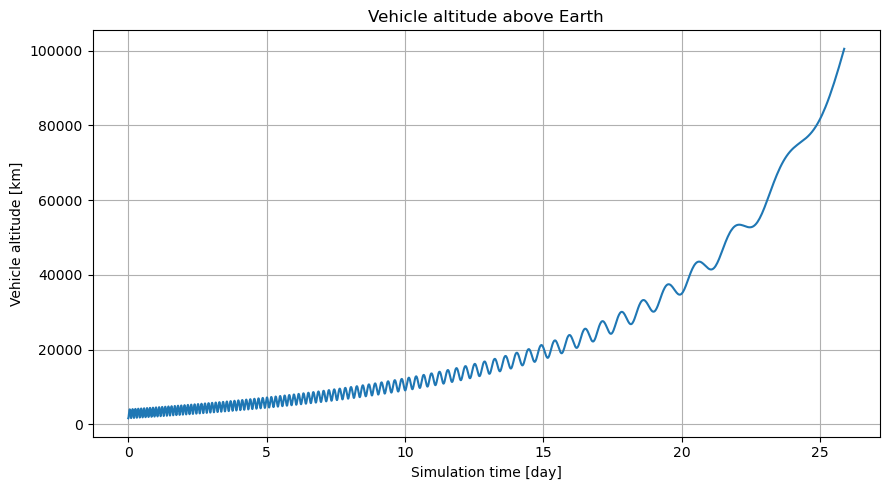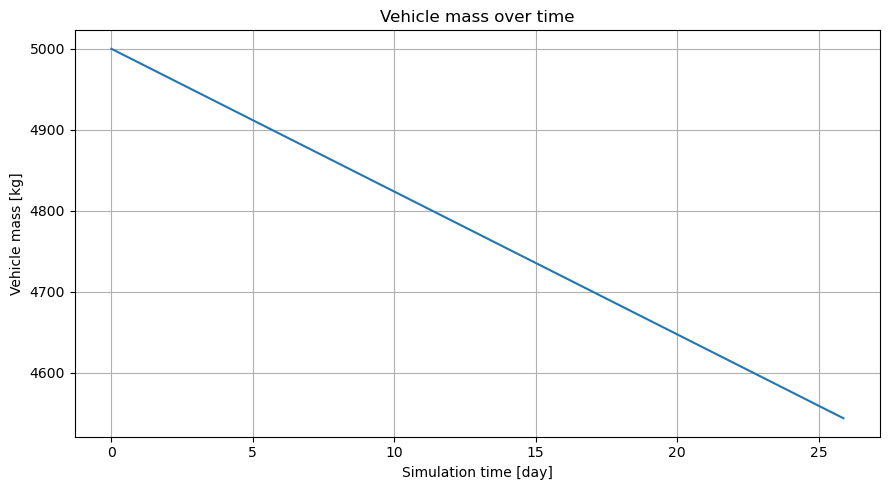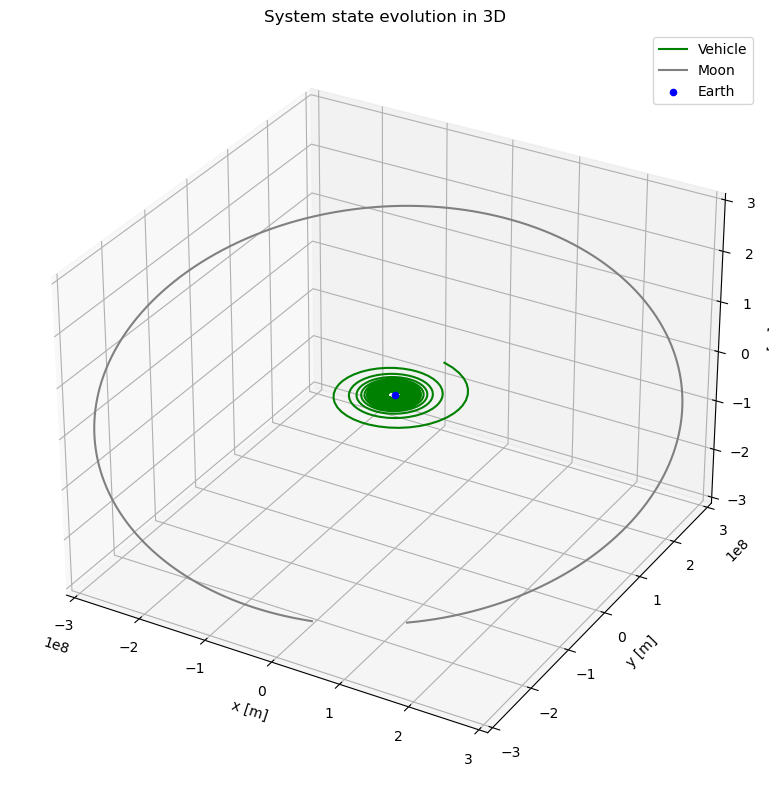Note
Generated by nbsphinx from a Jupyter notebook. All the examples as Jupyter notebooks are available in the tudatpy-examples repo.
Thrust between the Earth and the Moon
Copyright (c) 2010-2022, Delft University of Technology. All rights reserved. This file is part of the Tudat. Redistribution and use in source and binary forms, with or without modification, are permitted exclusively under the terms of the Modified BSD license. You should have received a copy of the license with this file. If not, please visit: http://tudat.tudelft.nl/LICENSE.
Context
This example demonstrates the basic use of thrust in the Earth-Moon system.
Thrust is implemented to be of constant magnitude and to be collinear with velocity (pushing the simulated vehicle from behind). In addition to the acceleration from the thrust, a basic model is set up, consisting of the acceleration of the Earth, Moon, and Sun, only considering them as point masses.
The mass of the vehicle is propagated using a mass rate model consistent with the rocket thrust used.
How to set up dependent variables to save the mass and altitude of the vehicle over time is demonstrated.
Termination settings based on the minimum mass of the vehicle and its maximum altitude are shown.
Finally, how to plot the trajectory of the Vehicle and of the Moon in 3D is demonstrated. For this purpose, this example also shows how to extract the position of the Moon over time from SPICE.
Import statements
The required import statements are made here at the beginning of the code.
Some standard modules are first loaded: numpy and matplotlib.pyplot.
The different modules of tudatpy that will be used are then imported.
[1]:
# # Load standard modules
import numpy as np
from matplotlib import pyplot as plt
# # Load tudatpy modules
from tudatpy.interface import spice
from tudatpy import numerical_simulation
from tudatpy.numerical_simulation import environment_setup, propagation_setup
from tudatpy import constants
from tudatpy.util import result2array
from tudatpy.astro.time_conversion import DateTime
Configuration
NAIF’s SPICE kernels are first loaded so that the position of various bodies such as the Earth can be make known to tudatpy.
Then the start and end simulation epochs are set up. In this case, the start epoch is set to 1e7, which corresponds to 10 million seconds (\(\approx\) 115.74 days) after the 1st of January 2000.
The times should always be specified in seconds since the epoch of J2000. Please refer to the API documentation of the time_conversion module here for more information on this.
[2]:
# # Load spice kernels
spice.load_standard_kernels()
[3]:
# # Set simulation start and end epochs (total simulation time of 30 days)
simulation_start_epoch = DateTime(2000, 4, 25).epoch()
simulation_end_epoch = simulation_start_epoch + 30 * constants.JULIAN_DAY
Environment setup
Let’s create the environment for our simulation. This setup covers the creation of (celestial) bodies, vehicle(s), and environment interfaces.
Create the bodies
Bodies can be created by making a list of strings with the bodies that are to be included in the simulation.
The default body settings (such as atmosphere, body shape, rotation model) are taken from SPICE.
These settings can be adjusted. Please refer to the Available Environment Models in the user guide for more details.
Finally, the system of bodies is created using the settings. This system of bodies is stored in the variable bodies.
[4]:
# # Define bodies in simulation
bodies_to_create = ["Sun", "Earth", "Moon"]
# # Create bodies in simulation
body_settings = environment_setup.get_default_body_settings(bodies_to_create)
system_of_bodies = environment_setup.create_system_of_bodies(body_settings)
Create the vehicle
Let’s now create the 5000 kg Vehicle for which the trajectory bewteen the Earth and the Moon will be propagated.
[5]:
# # Create the vehicle body in the environment
system_of_bodies.create_empty_body("Vehicle")
system_of_bodies.get_body("Vehicle").set_constant_mass(5e3)
Define the thrust guidance settings
Let’s now define the aspects of the body related to thrust: its orientation and its engine.
First, the thrust_direction_settings are set up so that the thrust is always acting aligned with the velocity vector of the vehicle, ensuring that the orbit is continuously raised.
Next the thrust_magnitude_settings are set up to indicate that a constant thrust of 10N is used.
[6]:
rotation_model_settings = environment_setup.rotation_model.orbital_state_direction_based(
central_body="Earth",
is_colinear_with_velocity=True,
direction_is_opposite_to_vector=False,
base_frame = "",
target_frame = "VehicleFixed" )
environment_setup.add_rotation_model( system_of_bodies, 'Vehicle', rotation_model_settings )
thrust_magnitude_settings = (
propagation_setup.thrust.constant_thrust_magnitude(
thrust_magnitude=10.0, specific_impulse=5e3 ) )
environment_setup.add_engine_model(
'Vehicle', 'MainEngine', thrust_magnitude_settings, system_of_bodies )
Propagation setup
Now that the environment is created, the propagation setup is defined.
First, the bodies to be propagated and the central bodies will be defined. Central bodies are the bodies with respect to which the state of the respective propagated bodies is defined.
[7]:
# # Define bodies that are propagated
bodies_to_propagate = ["Vehicle"]
# # Define central bodies of propagation
central_bodies = ["Earth"]
Create the acceleration model
First off, the acceleration settings that act on the Vehicle are to be defined. In this case, these consist of the followings: - Acceleration from the constant thrust, using the settings defined earlier. - Gravitational acceleration from the Earth, the Moon, and the Sun, all modeled as point masses.
The defined acceleration settings are then applied to the Vehicle in a dictionary.
Finally, this dictionary is input to the propagation setup to create the acceleration models.
[8]:
# # Define the accelerations acting on the vehicle
acceleration_on_vehicle = dict(
Vehicle=[
# Define the thrust acceleration from its direction and magnitude
propagation_setup.acceleration.thrust_from_engine( 'MainEngine')
],
# Define the acceleration due to the Earth, Moon, and Sun as Point Mass
Earth=[propagation_setup.acceleration.point_mass_gravity()],
Moon=[propagation_setup.acceleration.point_mass_gravity()],
Sun=[propagation_setup.acceleration.point_mass_gravity()]
)
# # Compile the accelerations acting on the vehicle
acceleration_dict = dict(Vehicle=acceleration_on_vehicle)
# # Create the acceleration models from the acceleration mapping dictionary
acceleration_models = propagation_setup.create_acceleration_models(
body_system=system_of_bodies,
selected_acceleration_per_body=acceleration_dict,
bodies_to_propagate=bodies_to_propagate,
central_bodies=central_bodies
)
Define the initial state
The initial state of the Vehicle that will be propagated is now defined.
In this example, this state is very straightforwardly set directly in cartesian coordinates.
The Vehicle will thus start 8,000 km from the center of the Earth, at a velocity of 7.5 km/s.
[9]:
# # Get system initial state (in cartesian coordinates)
system_initial_state = np.array([8.0e6, 0, 0, 0, 7.5e3, 0])
Define dependent variables to save
In this example, we are interested in saving not only the propagated state of the satellite over time, but also a set of so-called dependent variables that are to be computed (or extracted and saved) at each integration step.
This page of the tudatpy API website provides a detailled explanation of all the dependent variables that are available.
[10]:
# # Create a dependent variable to save the altitude of the vehicle w.r.t. Earth over time
vehicle_altitude_dep_var = propagation_setup.dependent_variable.altitude( "Vehicle", "Earth" )
# # Create a dependent variable to save the mass of the vehicle over time
vehicle_mass_dep_var = propagation_setup.dependent_variable.body_mass( "Vehicle" )
# # Define list of dependent variables to save
dependent_variables_to_save = [vehicle_altitude_dep_var, vehicle_mass_dep_var]
Create the termination settings
Let’s now define a set of termination settings. In this setup, once any single one of them is fulfilled, the propagation stops.
These settings are the following: - Stop when the altitude get above 100,000 km. - Stop when the Vehicle has a mass of 4,000 kg (burned 1,000 kg of propellant). - Stop when the Vehicle reaches the specified end epoch (after 30 days).
[11]:
# Create a termination setting to stop when altitude of the vehicle is above 100e3 km
termination_distance_settings = propagation_setup.propagator.dependent_variable_termination(
dependent_variable_settings = vehicle_altitude_dep_var,
limit_value = 100e6,
use_as_lower_limit = False)
# Create a termination setting to stop when the vehicle has a mass below 4e3 kg
termination_mass_settings = propagation_setup.propagator.dependent_variable_termination(
dependent_variable_settings = vehicle_mass_dep_var,
limit_value = 4000.0,
use_as_lower_limit = True)
# Create a termination setting to stop at the specified simulation end epoch
termination_time_settings = propagation_setup.propagator.time_termination(simulation_end_epoch)
# Setup a hybrid termination setting to stop the simulation when one of the aforementionned termination setting is reached
termination_settings = propagation_setup.propagator.hybrid_termination(
[termination_distance_settings, termination_mass_settings, termination_time_settings],
fulfill_single_condition = True)
Create the integrator settings
The last step before starting the simulation is to set up the integrator that will be used.
In this case, a RKF7(8) variable step integrator is used, which has a tolerance of \(10^{-10}\), can take steps from 0.01 s to 1 day, and starts at an initial step size of 10 s.
[12]:
# # Setup the variable step integrator time step sizes
initial_time_step = 10.0
minimum_time_step = 0.01
maximum_time_step = 86400
# # Setup the tolerance of the variable step integrator
tolerance = 1e-10
# # Create numerical integrator settings (using a RKF7(8) coefficient set)
integrator_settings = propagation_setup.integrator.runge_kutta_variable_step_size(
initial_time_step,
propagation_setup.integrator.rkf_78,
minimum_time_step,
maximum_time_step,
relative_error_tolerance=tolerance,
absolute_error_tolerance=tolerance)
Create the propagator settings
The propagator settings are now defined.
As usual, translational propagation settings are defined, using a Cowell propagator.
Next, mass propagation settings are also defined. The mass rate from the vehicle is set up to be consistent with the thrust used. The vehicle then loses mass as it loses propellant.
Finally, a multitype propagator is defined, encompassing both the translational and the mass propagators.
[13]:
# # Create the translational propagation settings (use a Cowell propagator)
translational_propagator_settings = propagation_setup.propagator.translational(
central_bodies,
acceleration_models,
bodies_to_propagate,
system_initial_state,
simulation_start_epoch,
integrator_settings,
termination_settings,
propagation_setup.propagator.cowell,
output_variables=[vehicle_altitude_dep_var, vehicle_mass_dep_var]
)
# # Create a mass rate model so that the vehicle loses mass according to how much thrust acts on it
mass_rate_settings = dict(Vehicle=[propagation_setup.mass_rate.from_thrust()])
mass_rate_models = propagation_setup.create_mass_rate_models(
system_of_bodies,
mass_rate_settings,
acceleration_models
)
# # Create the mass propagation settings
mass_propagator_settings = propagation_setup.propagator.mass(
bodies_to_propagate,
mass_rate_models,
[5e3], # initial vehicle mass
simulation_start_epoch,
integrator_settings,
termination_settings )
# # Combine the translational and mass propagator settings
propagator_settings = propagation_setup.propagator.multitype(
[translational_propagator_settings, mass_propagator_settings],
integrator_settings,
simulation_start_epoch,
termination_settings,
[vehicle_altitude_dep_var, vehicle_mass_dep_var])
Propagate the orbit
The orbit from the Earth to the Moon is now ready to be propagated.
This is done by calling the create_dynamics_simulator() function of the numerical_simulation module. This function requires the system_of_bodies and propagator_settings that have all been defined earlier.
After this, the history of the propagated state over time, containing both the position and velocity history, is extracted. This history, taking the form of a dictionary, is then converted to an array containing 7 columns: - Column 0: Time history, in seconds since J2000. - Columns 1 to 3: Position history, in meters, in the frame that was specified in the body_settings. - Columns 4 to 6: Velocity history, in meters per second, in the frame that was specified in the body_settings.
The same is done with the dependent variable history. The column indexes corresponding to a given dependent variable in the dep_vars variable are printed when the simulation is run, when create_dynamics_simulator() is called. Do pay attention that converting to an ndarray using the result2array() utility will shift these indexes because the first column (index 0) will then be the times.
[14]:
# # Instantiate the dynamics simulator and run the simulation
dynamics_simulator = numerical_simulation.create_dynamics_simulator(
system_of_bodies, propagator_settings)
# # Extract the state and dependent variable history
state_history = dynamics_simulator.state_history
dependent_variable_history = dynamics_simulator.dependent_variable_history
# # Convert the dictionaries to multi-dimensional arrays
vehicle_array = result2array(state_history)
dep_var_array = result2array(dependent_variable_history)
Get Moon state from SPICE
The state of the Moon at the epochs at which the propagation was run is now extracted from the SPICE kernel.
[15]:
# # Retrieve the Moon trajectory over vehicle propagation epochs from spice
moon_states_from_spice = {
epoch:spice.get_body_cartesian_state_at_epoch("Moon", "Earth", "J2000", "None", epoch)
for epoch in list(state_history.keys())
}
# # Convert the dictionary to a mutli-dimensional array
moon_array = result2array(moon_states_from_spice)
Post-process the propagation results
The results of the propagation are then processed to a more user-friendly form.
Altitude over time
Let’s first plot the altitude of the vehicle over time, as given in the second column of the dependent variable array (the first one being the epochs).
[16]:
# # Convert the time to days
time_days = (vehicle_array[:,0] - vehicle_array[0,0])/constants.JULIAN_DAY
# # Create a figure for the altitude of the vehicle above Earth
fig1 = plt.figure(figsize=(9, 5))
ax1 = fig1.add_subplot(111)
ax1.set_title(f"Vehicle altitude above Earth")
# # Plot the altitude of the vehicle over time
ax1.plot(time_days, dep_var_array[:,1]/1e3)
# # Add a grid and axis labels to the plot
ax1.grid(), ax1.set_xlabel("Simulation time [day]"), ax1.set_ylabel("Vehicle altitude [km]")
# # Use a tight layout for the figure (do last to avoid trimming axis)
fig1.tight_layout()

Vehicle mass over time
The mass of the Vehicle over time is now plotted. This shows that, as expected, the propellant being used for thrust gets removed from the Vehicle mass.
[17]:
# # Create a figure for the altitude of the vehicle above Earth
fig2 = plt.figure(figsize=(9, 5))
ax2 = fig2.add_subplot(111)
ax2.set_title(f"Vehicle mass over time")
# # Plot the mass of the vehicle over time
ax2.plot(time_days, dep_var_array[:,2])
# # Add a grid and axis labels to the plot
ax2.grid(), ax2.set_xlabel("Simulation time [day]"), ax2.set_ylabel("Vehicle mass [kg]")
# # Use a tight layout for the figure (do last to avoid trimming axis)
fig2.tight_layout()

Plot trajectories in a 3D Projection
Finally, let’s plot the state of the Vehicle and of the Moon in three dimensions.
[18]:
# # Create a figure with a 3D projection for the Moon and vehicle trajectory around Earth
fig3 = plt.figure(figsize=(8, 8))
ax3 = fig3.add_subplot(111, projection="3d")
ax3.set_title(f"System state evolution in 3D")
# # Plot the vehicle and Moon positions as curve, and the Earth as a marker
ax3.plot(vehicle_array[:,1], vehicle_array[:,2], vehicle_array[:,3], label="Vehicle", linestyle="-", color="green")
ax3.plot(moon_array[:,1], moon_array[:,2], moon_array[:,3], label="Moon", linestyle="-", color="grey")
ax3.scatter(0.0, 0.0, 0.0, label="Earth", marker="o", color="blue")
# # Add a legend, set the plot limits, and add axis labels
ax3.legend()
ax3.set_xlim([-3E8, 3E8]), ax3.set_ylim([-3E8, 3E8]), ax3.set_zlim([-3E8, 3E8])
ax3.set_xlabel("x [m]"), ax3.set_ylabel("y [m]"), ax3.set_zlabel("z [m]")
# # Use a tight layout for the figure (do last to avoid trimming axis)
fig3.tight_layout()
plt.show()
